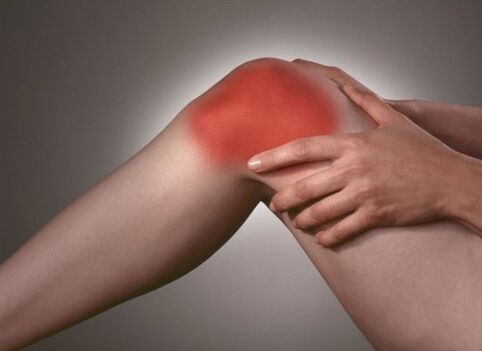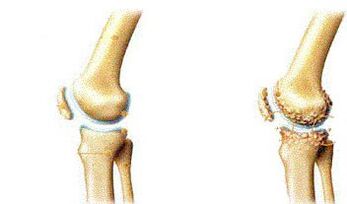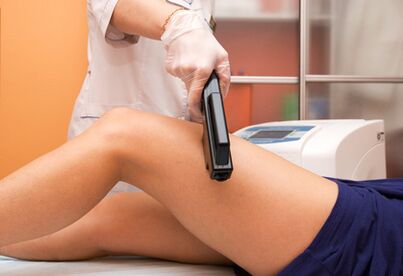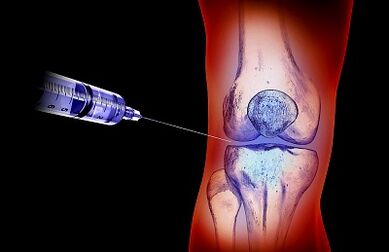
The knee, like other joints of a person, consists of bone and cartilage.The cartoon is a soft, elastic and elastic layer that guarantees the ease of march and lack of friction.Cartilage damage is called chronic clothingOsteoarthritis of the knee joint.
There are many factors that lead to the osteoarthritis of the knee joint:
- genetic predisposition;
- overweight;
- abnormal movement;
- injuries
For a long time, a person does not experience pain and only when knee osteoarthritis leads to strain deformation, the first symptoms appear.The patient consults a doctor, but the treatment of an advanced disease can be successful.
The osteoarthritis of the knee joint is often a consequence of accidents and injuries, but can only manifest after a few years.Therefore, with the slightest suspicion of this disease, you must consult a doctor.
Symptoms of osteoarthritis of the knee joint
The symptoms of the osteoarthritis of the knee joint include:

- Increase in pain during activity;
- swelling;
- increasing skin temperature;
- decrease in knee joint mobility;
- The crunch, the crunchy sound that is heard during the movement.
Pain after inaction periods is one of the most common symptoms of knee osteoarthritis.She expresses himself in the morning, when the joints need time to warm up in the right way.After a person is like a time, pain decreases.
Sometimes you can notice the first signs of knee osteoarthritis simply looking at it.Even if the knee stands out more than usual, this can be the first signal.The greatest trend of the knee to swelling is easy to recognize.The bulge on the thick finger is formed on the knee cup, since this place is the weakest.This is due to an increase in the accumulation of fluid in the joint.
The reduction in leg flexibility can indicate the osteoarthritis of the knee joint.Those who used to touch the heels of the buttocks, standing in one leg, but can go halfway today, should consult a doctor.The muscles of the thigh can begin to function more difficult than before, due to the osteoarthritis of the knee, shortening, and starting to hurt.These muscles must stretch and strengthen to restore the above functions.
Another sign of osteoarthritis of the knee joint is the decrease in muscle strength in the legs.
Arthrosis rotates the cartilage, which is soft as glass on a rough cloth that looks like sandpaper in the early stages.When these surfaces rub each other, you can listen to the crunch and friction sounds in the joint.
How is knee osteosis diagnosed?

The diagnosis of knee osteoarthritis will begin with a medical examination by a doctor.Before taking, determine what pain arises to help the doctor make the correct diagnosis.In addition, finding if someone has arthritis in their family.
Your doctor can prescribe an additional diagnosis, which includes:
- The magnetic resonance images (MRI) radiographs that can show bones and damage to the cartilage, as well as the presence of bone spurs;
- Magnetic resonance can be ordered when radiographs do not give a clear cause of joint pain or when radiographs show that other types of joint tissue can be damaged.Doctors can use blood tests to exclude other conditions that can cause pain, such as rheumatoid arthritis, another type of arthritis caused by a deteriorated immune system.
How is the osteoarthritis of the knee joint about?
The main tasks of treating the osteoarthritis of the knee joint are the relief of pain and the return of mobility.
Treatment Plan, as a rule, includes a combination of the following actions:
- Weight loss.The loss of even a small amount of weight, if necessary, can significantly reduce pain in the knee of osteoarthritis.
- Exercise.Strengthening muscles around the knee makes the condition of the joints more stable and reduces pain.Stretching exercises help maintain the joint and flexible knee joint.
- Anesthetic and anti -inflammatory drugs:Acetaminophen, ibuprofen or sodium.If medications do not bring relief, your doctor can give you a recipe from another anti -inflammatory medication to help relieve pain.
- Corticosteroid injections or hyaluronic acid in the knee.Steroids are powerful anti -inflammatory drugs.Hyaluronic acid is generally present in joints as a type of lubricant, but with joint diseases categorically lacks.
- Alternative treatment methods.Some alternative methods of treatment that can be effective: Capsaicin, acupuncture or additive creams, including glucosamine and chondroitin.
- Use of devices such as supports.There are two types of supports: those that discharge orthopedic devices, thus eliminating the weight of the knee side;and "support" supports that provide support for the entire knee.
- Physical activity and labor therapy. If you have problems with daily activities, physical exercises or job therapy can help.Physiotherapists will teach you how to strengthen the muscles and increase flexibility in the joint.The specialists will compose a set of adequate exercises for you to work at home to reduce pain.
- Surgery.When other treatment methods do not work, surgery is the only option to get rid of the disease.

Is surgery used to treat knee osteoarthritis?
For the treatment of knee osteoarthritis with the help of surgical intervention, the following options are possible: arthroscopy, osteotomy, endoprothetic.
InarthroscopyA small telescope (arthroscope) and other small tools are used.The operation is carried out through small incisions.The surgeon uses an arthroscope so that the joint can be seen.After the surgeon can eliminate cartilage or damaged free particles, you can clean the bone surface.The procedure is often used in 55 -year -old patients (and younger) to delay a more serious operation.
Osteotomy- This is a procedure that seeks to align the knee, changing the shape of the bones.This type of operation can be recommended if you have damage, first of all, in an area of the knee.It can also be recommended if it damaged the knee and has not been restored.Osteotomy does not have a constant effect and surgery may be required in the future.
Endoprotetics- This is a surgical procedure in which the joints are replaced by artificial metal or plastic parts.The replacement can include a side or all knee.As a general rule, people over 50 and a serious way of osteoarthritis need replacement.The operation can be required later, if the replacement is wearing after several years, but with modern achievements, most prostheses have been serving for more than 20 years.The operation has risks, but the results are usually very good.



















